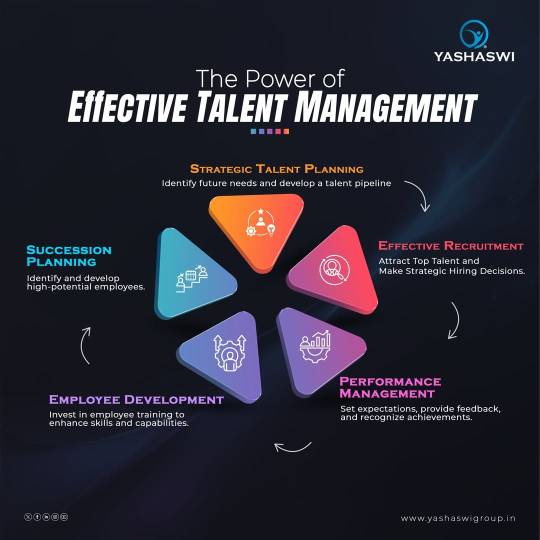#Employee Engagement Strategy
Explore tagged Tumblr posts
Text
5 Employee Engagement Best Practices for a Thriving Workforce

There has been a significant shift in workforce trends in recent years. The evident rise in employee turnover, decline in productivity, and surge in absenteeism show that merely paying high wages to employees is not enough. This marks the urgency of a concept that can help align employees with organizational goals and success.
'Employee engagement,' the concept that measures employees' dedication and enthusiasm towards their jobs, can help organizations effectively manage their workforce. However, there exists a huge gap between grasping the concept and putting it into practice at the grassroots level. Here are the 5 best practices for modern organizations to create a super-engaged workforce.
1. Facilitating uninterrupted internal communication - Simplifying internal communication channels can be the first step towards creating workforce engagement strategies. Enabling employees to access key company news and announcements, project updates, and event highlights helps them align with the company's goals and future endeavors. Effective communication also bridges the gap between employee-employee and employee-management interaction, eventually contributing to improved collaboration and decision-making.
2. Leveraging employee recognition tactics - When recognized and appreciated at the workplace, employees are more likely to display dedication and commitment towards their job role. Simply sending wishes to the employees on birthdays and work anniversaries, appreciating their performance, and celebrating milestones together can help enhance engagement levels across the organization.
3. Streamlining employee onboarding - The onboarding process marks the first interaction for a newly hired employee within the organization. Streamlining standard forms, automating documentation, and simplifying internal communication can help them smoothly complete the onboarding process. Also, offering them access to co-workers' profiles and key knowledge resources can help them understand their role and integrate faster with organization.
4. Conducting regular surveys and feedback - Conducting surveys within the organization is a time-tested method for collective decision-making and employee participation. Regular surveys and feedback enable organizations to identify concerns and take proactive measures for employees, contributing to enhanced workplace experience. Empowering employees to contribute to surveys helps improve communication, build trust, and strengthen communication, which is necessary to drive engagement, productivity, and retention.
5. Empowering employees with updated tools - Employees' interaction with workplace technology also plays a crucial role in deciding their levels of engagement. The right digital platform enhances communication and collaboration within the organization and offers employees adequate productivity tools to manage their tasks, documents, events, and more all in one place—all leading to lesser burnout, elimination of errors, and increased efficiency. Choosing the right platform definitely serves as a catalyst to maximize your workforce's engagement.
In Conclusion - Overall, employee engagement practices aim to place employees at the center of the organizational framework to create a workforce committed to the organizational goals and values. However, empowering employees with a robust communication and collaboration platform, along with implementing strategies to enrich employees' workplace experience, can help cultivate a culture of transparency, belonging, and collective advancement.
0 notes
Text
How to Form and Run an Employee Engagement Committee?
If you were a human resource professional, you're more than likely concerned with having a successful employee engagement strategy in place. But what does a successful employee engagement strategy mean? And how do you build a successful system in the first place? This blog will dive into one of the essential parts of developing a successful strategy: curating an employee engagement committee. To do so, we will go over everything concerned with employee engagement committees, such as what they are, why they are essential, and how to best use them.
0 notes
Text
Do you want updated handbooks? Do you want to build compliance among employees? One solution to all your problems! Invest in your HR team's development! We equip HR professionals with the skills and knowledge needed. They excel in their roles and will help you excel too!
2 notes
·
View notes
Text
12 Best Employee Retention Strategies for Your Business

The ability to retain employees is essential to the operation of a successful company. Hiring and training new employees can be time-consuming and costly, making it essential to retain top talent. When employees feel valued and engaged, they are more likely to stay with their current employer and contribute to the company's success. To help you retain your best employees, here are 12 effective employee retention strategies for your business.
Competitive Compensation and Benefits:
Offering competitive compensation and benefits is one of the most effective strategies for retaining employees. Employees need to feel that their hard work and dedication are rewarded with fair pay and benefits. Regularly review and benchmark your compensation packages to ensure they are competitive in the market.
Opportunities for Growth and Development:
Providing opportunities for growth and development is crucial for employee retention. Employees want to know that their careers can progress within the organization. Offer training programs, mentorship, and opportunities for skill development to help employees enhance their skills and advance their careers.
Work-Life Balance:

Achieving work-life balance is important to employees, and organizations that prioritize work-life balance tend to have higher employee retention rates. Encourage a healthy work-life balance by offering flexible work arrangements, such as remote work options or flexible working hours.
Recognition and Appreciation:
Recognizing and appreciating employees for their hard work and contributions are a powerful retention strategy. Acknowledge their achievements, provide feedback, and celebrate their successes. Employee recognition programs or regular feedback sessions can help employees feel valued and motivated to stay with the company.
Strong Company Culture:
A positive and inclusive company culture can significantly impact employee retention. Create a culture that promotes open communication, collaboration, and mutual respect. Foster a sense of belonging and ensure employees feel connected to the organization's mission, vision, and values.
Employee Engagement:
Engaged employees are more likely to stay with their employer. Involve employee engagement solutions in decision-making processes, seek their input, and encourage feedback. Provide opportunities for employees to contribute their ideas and opinions, and recognize and reward their contributions.
Clear Career Path:
Employees are more likely to stay with a company if they can see a clear career path. Provide employees with a roadmap for career advancement within the organization. Set clear expectations, provide regular feedback on their performance, and offer guidance on how they can progress in their careers.
Workforce Diversity and Inclusion:
Embrace diversity and inclusion in your workplace. Create a welcoming and inclusive environment where employees from all backgrounds feel valued and respected. Promote diversity in hiring, promotions, and leadership positions. Employee loyalty is higher at organizations that value and champion inclusion and diversity.
Employee Wellness Programs:

The employee wellness programs can help improve employee retention by promoting employee well-being. Offer wellness initiatives such as fitness programs, mental health support, and work-life balance resources. These programs can help employees manage stress, maintain their health, and improve their overall well-being.
Strong Leadership:
Leadership plays a crucial role in employee retention. Invest in developing strong leaders who can effectively manage and lead teams. Provide leadership training and mentorship programs to help managers build the skills needed to engage and retain employees.
Employee Surveys and Feedback:
Regularly solicit feedback from employees through surveys or other means to understand their concerns, suggestions, and needs. Use this input to pinpoint areas that need improvement and implement the appropriate adjustments. Show employees that their feedback is valued and acted upon, which can contribute to their job satisfaction and retention.
Exit Interviews and Retention Analysis:
Conduct exit interviews with departing employees to understand their reasons for leaving and gather feedback on their experience with the organization. Use this information to identify any retention issues and implement appropriate measures to address them. Analyze retention data and trends to identify patterns and take proactive steps to retain your employees.
Also Watch: EmpMonitor Review: The Best Employee Monitoring Software
youtube
Summing Up
Any firm that wants to succeed must be able to keep its best employees. Implementing effective employee retention strategies can help you create a positive work environment, engage and motivate your employees, and reduce turnover. By offering competitive compensation and benefits, providing opportunities for growth and development, promoting work-life balance, recognizing and appreciating employees, fostering strong company culture, encouraging employee engagement, providing clear career paths, promoting diversity and inclusion, offering employee wellness programs, developing strong leadership, soliciting employee feedback, and conducting exit interviews and retention analysis, you can create a workplace where employees feel valued, engaged, and motivated to stay for the long term.
2 notes
·
View notes
Text
Engaging Employees Through CSR: Building a Culture of Purpose
Introduction In today’s competitive business landscape, fostering employee engagement is more crucial than ever. One of the most effective and enriching strategies for engaging employees is through Corporate Social Responsibility (CSR). Engaging employees through CSR not only enhances workplace culture but also aligns an organization’s objectives with societal needs, creating a culture of…
#best practices for brand management#Branding strategies for small businesses#Building#building brand loyalty#business growth strategies#corporate social responsibility#creating a strong brand identity#CSR#Culture#customer relationship management#digital marketing for startups#e-commerce tips for businesses#Employees#Engaging#how to scale your business.#how to start a successful business#importance of social media for businesses#influencer marketing for brands#Purpose#small business funding options#top business trends 2024
0 notes
Text
5 Proven Employee Engagement Strategies to Boost Productivity
Employee engagement is more than just a buzzword; it’s the backbone of a productive and thriving workplace. Organizations that invest in employee engagement strategies experience higher retention rates, increased motivation, and improved overall performance. But how can you ensure that your employees are truly engaged and motivated?
At Prolite, we specialize in crafting meaningful employee engagement activities that foster collaboration, innovation, and a strong workplace culture. Here are five proven employee engagement strategies to boost productivity in your organization.
1️. Foster a Culture of Recognition and Appreciation
Employees thrive in an environment where their contributions are acknowledged and appreciated. Recognition goes beyond just monetary rewards—it includes verbal praise, peer appreciation, and public acknowledgment of achievements.
🔹 How to Implement:
Create a structured rewards and recognition program where employees are celebrated for their hard work.
Use platforms like Slack, Microsoft Teams, or internal portals to give real-time shoutouts.
Organize monthly appreciation events where top performers are recognized in front of their peers.
Pro Tip: Try peer-to-peer recognition programs where employees can recognize their colleagues' efforts. This builds camaraderie and strengthens team engagement activities.
2️. Encourage Team Engagement Activities & Bonding Events
Teamwork and collaboration drive productivity. When employees feel connected to their colleagues, they are more likely to contribute actively and stay engaged.
🔹 How to Implement:
Organize corporate team building activities such as escape rooms, outdoor challenges, or hackathons.
Implement regular team lunch-and-learn sessions where employees can share knowledge and ideas.
Encourage cross-departmental projects to break silos and improve communication.
Pro Tip: Offsite events and retreats are excellent ways to strengthen bonds while allowing employees to refresh and refocus.
3️. Invest in Virtual Team Engagement Activities for Remote Workers
With the rise of remote and hybrid work models, keeping virtual teams engaged is crucial. Without physical interaction, employees can feel disconnected, leading to a drop in productivity.
🔹 How to Implement:
Conduct virtual team building activities like trivia games, online escape rooms, and virtual happy hours.
Host weekly or bi-weekly check-ins and virtual coffee breaks to maintain a sense of connection.
Use tools like Slack, Zoom, or MS Teams to encourage informal chats and collaboration.
Pro Tip: Create a virtual watercooler channel where employees can share personal wins, fun facts, or random thoughts to foster engagement.
4️. Provide Opportunities for Growth & Learning
Employees are more engaged when they see a clear path for growth and development within the organization.
🔹 How to Implement:
Offer upskilling and training programs tailored to employees' career aspirations.
Implement a mentorship program where experienced professionals guide junior employees.
Support employees in attending industry conferences, webinars, and professional development events.
Pro Tip: Create a Learning Festival—a week-long event where employees can join workshops, engage in skill-building sessions, and collaborate on innovative ideas.
5️. Promote Open Communication & Employee Feedback
Transparency and open dialogue are essential for a thriving workplace. Employees should feel that their opinions matter and that leadership values their input.
🔹 How to Implement:
Conduct quarterly employee engagement surveys to understand their needs and concerns.
Hold open-door meetings where employees can share ideas directly with leadership.
Act on feedback by implementing relevant suggestions and keeping employees informed on changes.
Pro Tip: Use anonymous feedback platforms to encourage honest input without fear of judgment.
Final Thoughts
A well-engaged workforce is a productive, motivated, and committed workforce. By implementing these five employee engagement strategies, companies can create a thriving workplace where employees feel valued, connected, and driven to succeed.
At Prolitee, we specialize in customized employee engagement activities, team engagement activities, and virtual team engagement activities tailored to enhance workplace productivity and collaboration.
💡 Which engagement strategy has worked best for your team? Share your thoughts in the comments! Let’s build a workplace culture that thrives! 🚀
#EmployeeEngagement #TeamBuilding #CorporateCulture #WorkplaceProductivity
#employee engagement strategies#employee engagement#Employee Engagement Activities#team engagement activities#virtual team engagement activities
0 notes
Text
Understanding Organizational Culture and Leadership
Organizational culture isn't just a buzzword—it's the foundation of business success. #Leadership #CompanyCulture #BusinessGrowth #Innovation #WorkplaceSuccess #EmployeeEngagement #OrganizationalDevelopment #VisionAndMission
In today’s dynamic business landscape, organizational culture plays a crucial role in shaping a company’s success. From guiding employee behavior to influencing overall performance, culture is more than just a buzzword—it’s a fundamental pillar of effective leadership and organizational success. What is Organizational Culture? Organizational culture refers to the shared values, beliefs, and…
#business growth#business strategy#company values#corporate culture#employee engagement#executive leadership#innovation#leadership#leadership styles#mission statement#organizational culture#professional development#Servant Leadership#strategic planning#team motivation#transactional leadership#Transformational Leadership#vision statement#workplace productivity#workplace success
0 notes
Text
Motivation and Related Concepts

Motivation is a cornerstone of organizational success, representing the drive, energy, and commitment that employees bring to their roles every day. A well-motivated workforce is a powerful asset, enabling companies to meet objectives, enhance productivity, and achieve higher levels of output. This article delves into the intricate world of motivation and its related concepts, providing actionable insights for business leaders, HR consultants, and organizational behavior experts.
Understanding Motivation
Motivation refers to the internal and external factors that stimulate an individual to act towards achieving a goal. It encompasses the energy and focus required to perform tasks efficiently. In a workplace setting, motivation drives employees to align their efforts with organizational objectives, fostering a culture of excellence.
Types of Motivation
Motivation can be broadly categorized into two types:
Intrinsic Motivation: This is the internal drive that encourages individuals to engage in activities for personal satisfaction or a sense of achievement. For instance, an employee might take pride in mastering a challenging task because it enhances their skill set.
Extrinsic Motivation: This stems from external factors such as rewards, recognition, or fear of consequences. Bonuses, promotions, and public acknowledgment are common examples.
Why Motivation Matters
The significance of motivation in the workplace cannot be overstated. Here are a few key reasons why it is critical:
1. Boosts Productivity
Motivated employees are more likely to perform at their best, resulting in higher productivity. They are committed to delivering quality work and meeting deadlines, which drives organizational growth.
2. Enhances Employee Satisfaction
A motivated workforce experiences higher job satisfaction. When employees feel valued and inspired, they are more likely to stay loyal, reducing turnover rates.
3. Promotes Innovation
Motivated individuals often take initiative, think creatively, and contribute innovative solutions. They are more inclined to experiment with new ideas and improve processes.
4. Facilitates Team Collaboration
Motivation fosters a positive work environment where employees collaborate effectively. This synergy enhances team performance and strengthens workplace relationships.
Theories of Motivation
Several theories provide insights into the mechanisms of motivation:
1. Maslow’s Hierarchy of Needs
Abraham Maslow proposed that human needs are arranged in a hierarchy, starting with physiological needs and advancing to self-actualization. Employers can motivate their workforce by addressing these needs progressively.
2. Herzberg’s Two-Factor Theory
Herzberg identified two factors influencing motivation: hygiene factors (e.g., salary, work conditions) and motivators (e.g., recognition, opportunities for growth). To boost motivation, organizations must focus on enhancing motivators while addressing hygiene factors.
3. Self-Determination Theory (SDT)
SDT emphasizes the importance of autonomy, competence, and relatedness in fostering intrinsic motivation. Providing employees with a sense of control, opportunities for skill development, and a supportive environment can significantly enhance their motivation levels.
Strategies to Enhance Motivation
Implementing effective strategies can significantly improve employee motivation and organizational outcomes. Here are some proven approaches:
1. Recognize and Reward Contributions
Acknowledging employees’ efforts boosts morale and reinforces positive behavior. Recognition can take many forms, such as verbal praise, awards, or monetary incentives.
2. Provide Opportunities for Growth
Employees are more motivated when they see opportunities for career advancement. Training programs, mentorship, and clear career paths can help.
3. Foster a Positive Work Culture
A supportive and inclusive work environment encourages employees to thrive. Leaders should promote open communication, celebrate diversity, and address conflicts promptly.
4. Set Clear Goals and Expectations
Clarity in roles and responsibilities helps employees focus their efforts effectively. SMART (Specific, Measurable, Achievable, Relevant, Time-bound) goals can guide performance.
5. Empower Employees
Granting employees autonomy in decision-making fosters a sense of ownership and accountability. Empowered employees are more likely to take initiative and innovate.
6. Provide Regular Feedback
Constructive feedback helps employees understand their strengths and areas for improvement. Regular performance reviews and one-on-one discussions can keep them engaged and motivated.
The Role of Leadership in Motivation
Leaders play a pivotal role in cultivating a motivated workforce. Effective leadership involves inspiring and guiding employees toward achieving shared goals. Here are some leadership practices to enhance motivation:
Lead by Example: Demonstrating commitment and enthusiasm sets a positive tone.
Communicate Effectively: Transparent communication builds trust and alignment.
Show Empathy: Understanding employees’ challenges and offering support fosters loyalty.
Encourage Collaboration: Creating opportunities for teamwork enhances collective motivation.
Measuring Motivation
Assessing motivation levels can help organizations tailor their strategies. Common methods include:
Surveys and Questionnaires: Collecting employee feedback on job satisfaction and engagement.
Performance Metrics: Analyzing productivity and quality indicators.
Employee Turnover Rates: High retention often reflects positive motivation levels.
Conclusion
Motivation and related concepts are indispensable for organizational success. By understanding the nuances of motivation and implementing targeted strategies, businesses can unlock their employees’ full potential. A motivated workforce drives innovation, enhances productivity, and builds a resilient organization capable of thriving in today’s competitive landscape.
0 notes
Text
https://cogentibs.com/gamification-in-the-workplace-how-it-can-improve-team-performance/

Gamification in the Workplace: How it can improve team performance
In this era of work where competition is inevitable, organizations have to find means of maximizing team performance. One of the innovative approaches that have emerged is what is referred to as gamification in the workplace, which involves bringing the elements of games into the workplace to boost engagement.
#Workplace Engagement#Gamification in Workplace#Employee Motivation#Team Performance Enhancement#Productivity Improvement Strategies
0 notes
Text
Why Is an Employee Feedback Platform Essential for Your Business?
Employee feedback is a powerful tool for improving workplace culture, increasing satisfaction, and driving company success. However, with the rise of digital tools and platforms, collecting and acting on employee feedback has always been challenging. In today’s world, a robust feedback platform is not just nice to have—it’s essential for businesses that want to stay competitive and foster a positive, productive work environment.
How Employee Feedback Drives Positive Organizational Change?
An employee feedback platform is a digital tool that allows employees to provide feedback on various aspects of their workplace experience, including management, culture, work processes, and benefits. It typically includes features such as:
Pulse Surveys: Short, frequent surveys to measure employee sentiment in real time.
Anonymous Feedback Options: Ensuring employees feel comfortable providing honest feedback without fear of retaliation.
Actionable Insights: Tools that analyze feedback and provide recommendations to improve employee experience.
Employee Feedback Platform Boosts Employee Satisfaction
Employee satisfaction thrives when employees feel their voices are heard. A feedback platform can boost satisfaction by:
Addressing Concerns Quickly: Identify and resolve issues before they escalate.
Personalizing Employee Experience: Understand individual needs and preferences to create a more tailored work environment.
Fostering Trust: Employees feel valued and more connected to the organization when feedback leads to real change.
What Types of Feedback Should Be Collected?
Not all feedback is created equal. The most impactful feedback includes:
Job Satisfaction: Understanding employees' feelings about their roles, responsibilities, and work-life balance.
Managerial Feedback: Gauging how employees view their direct supervisors and leadership styles.
Company Culture: Measuring alignment with company values and overall organizational climate.
Wellness Feedback: Assessing mental health, workload, and general well-being.
How to Implement an Effective Feedback System in Your Organization?
To implement a successful feedback system:
Choose the Right Platform: Select a platform that is easy to use, customizable, and integrates well with your company’s existing tools.
Encourage Participation: Regularly remind employees of the importance of their feedback and how it will be used.
Act on Feedback: Ensure feedback leads to actionable changes, showing employees that their opinions matter.
Conclusion:
Employee feedback platforms create a cycle of continuous improvement by listening to employee concerns, acting on them, and improving the workplace environment. This process leads to higher employee satisfaction, lower turnover, and improved overall performance. A culture of feedback strengthens trust and aligns company goals with employee needs, making it a vital element in today’s business success.
0 notes
Text
#Best team outing places in Delhi for corporate team building#Corporate team building#Corporate team building activities#Employee engagement#Productivity Improvement#Team Building Strategies#Workplace Bonding Activities
0 notes
Text
Discover actionable employee engagement strategies to foster a positive work culture and boost productivity. Empower your organization with innovative approaches to recognition and morale-building. Drive success by nurturing a motivated workforce.
0 notes
Text
The Importance of Effective Talent Management for Organizational Success

Previously, businesses thrived entirely on their products and services. But times have changed. Today, the real conflict is the talent competition. Organizations can increase performance, obtain a competitive advantage, and succeed over the long run with efficient talent management. It is no longer only an HR job; it is a strategic requirement with a significant impact on a company’s success. Increasing productivity, decreasing turnover, and fostering creativity are just a few of the advantages that organizations may reap by successfully luring, nurturing, and retaining performing employees.
What is Talent Management?
It’s a systematic approach to improving an organization’s human resources that includes a variety of HR strategies such as talent acquisition, skill development, performance management, succession planning, and retention. Organizations may enhance employee engagement, increase productivity, and cultivate a high-performance culture by managing personnel well.
Here are some key benefits that highlight its importance.
Enhanced Organisational Performance:
A trained and motivated workforce is the foundation for corporate success. Organizations that systematically acquire, develop, and retain outstanding personnel can greatly increase their overall performance.
Improved Employee Retention:
A well-executed talent management plan promotes a healthy work environment and increases employee loyalty and happiness. Organizations can reduce turnover by providing opportunities for professional growth, development, and recognition.
Better Engagement of Workers:
Employees who are engaged are more productive, imaginative, and committed to their organization’s goals. Regular performance reviews, career development planning, and efficient communication are examples of talent management strategies that can greatly improve employee engagement and morale.
Futureproofing:
A proactive approach to talent management enables firms to discover and nurture future leaders. Organizations are ensuring their workforce is prepared to adjust to shifting market trends and company needs by investing in learning and development.
Best Practices for Talent Management:
Consider these essential best practices for optimizing talent management.
Use Data Driven Decisions:
Analyse data to better understand workforce trends, identify talent gaps, and evaluate the efficacy of talent initiatives. Use these findings to create well-informed recruitment, development, and retention strategies. For instance, examining turnover rates can reveal opportunities to improve employee engagement and happiness.
Continuous Learning Opportunities:
Invest in continuous training and development initiatives to upskill and reskill your personnel. This improves staff capacities while also increasing morale and engagement. Create individualized growth plans, mentorship programs, and possibilities for professional progression.
Diversity and Inclusion:
Create a workplace culture that values diversity, equity, and inclusion, ensuring that each employee feels appreciated, respected, and empowered. This may be accomplished by bringing in people from a variety of backgrounds, offering equitable chances for professional advancement, and fostering a feeling of community inside the company. A diverse workforce provides distinct viewpoints, resulting in increased creativity, innovation, and more effective problem solutions. By developing such an open atmosphere, organizations can unleash their workers’ full potential and create a vibrant, forward-thinking company.
Performance Monitoring and Feedback:
Establish a strong performance management system that includes frequent performance evaluations, goal setting, and feedback. This facilitates the alignment of individual goals with corporate objectives, the recognition and reward of top performers, and the proactive resolution of performance difficulties.
Employee Experience:
By creating a good and supportive work environment. This involves providing flexible work arrangements, comprehensive and competitive remuneration and benefits, and encouraging a positive work-life balance. An environment where workers feel appreciated and supported raises job satisfaction, boosts productivity, and increases employee retention. Prioritizing employee well-being not only boosts morale but also fosters a loyal and engaged staff, which supports long-term growth.
Elevate Your Workforce with Effective Talent Management
Effective personnel management is no longer a luxury; it is an essential component of corporate success. Organizations that deliberately acquire, develop, and retain people may improve performance, increase employee retention, promote engagement, and future-proof their workforce. These initiatives promote innovation, adaptation, and resilience, allowing firms to prosper in today’s competitive environment. Companies that prioritize continuous learning, diversity, performance management, and a great employee experience may build a high-performing, engaged staff that drives long-term success.
#talent management#Workforce management#Human resource management#Talent development#Performance management#Employee engagement#Succession planning#Talent optimization#HR solutions#Recruitment strategy
0 notes
Text
Leaders and Managers
Photo by August de Richelieu A Leader Does Not Need to Be a Manager, but a Manager Needs to Be a Leader In the dynamic world of business, the terms leaders and managers are often used interchangeably. However, they represent distinct roles with unique responsibilities and skill sets. While a leader does not necessarily need to be a manager, a manager must embody leadership qualities to be…
#Agile Leadership#Change Management#Coaching#Communication#Conflict Resolution#Decision-Making#Diversity and Inclusion#Emotional Intelligence#Employee Engagement#Innovation#leadership#management#Mentorship#Motivation#Organizational Culture#Performance Management#Productivity#Strategy#Team Building#Visionary leadership
0 notes
Text
Safeguarding Reputation Through Responsible Business Communication

Effective communication is crucial for maintaining the reputation and operational success of any business. With the continuous exchange of information between companies, external agencies, and individuals, the way an organization communicates can significantly impact its revenue and brand image. Miscommunication, delays, or negligence in responding to incoming or outgoing messages can pose significant risks. Therefore, companies must implement structured practices and safeguards to manage communication responsibly.
Importance of Responsible Communication
Every communication an employee makes on behalf of their company reflects directly on the organization. Irresponsible or careless messages, especially in written form, can lead to disputes, loss of revenue, or even legal consequences. For example, ignoring critical correspondence like legal notices, complaints, or contract details can have financial and reputational repercussions. This emphasizes the need for businesses to ensure every communication is carefully crafted, delivered, and managed.
Managing Incoming Communication
Prompt attention to all incoming messages is vital. Whether it's a customer inquiry, a legal document, or feedback, every communication must be acknowledged and addressed responsibly. Delays in responding or ignoring important messages can escalate issues unnecessarily. Companies should establish processes for systematically managing incoming communications, ensuring no critical information is overlooked.
Regulating Outgoing Communication
Outgoing communication, particularly in written forms like emails, letters, contracts, or agreements, must follow strict protocols. To avoid errors, businesses should develop standardized formats for recurring communication needs. Examples include quotations, customer query responses, complaint acknowledgments, interview invitations, offer letters, and employee certificates. These pre-approved templates reduce the risk of inconsistency and ensure professionalism in external communications.
Role of Training and Expertise
Not all employees possess the skills or awareness required for drafting appropriate business communication. Training programs focused on effective communication should be conducted regularly to equip employees with the necessary skills. Immaturity or ignorance in drafting sensitive messages should not be allowed to impact business operations. Additionally, companies should have a communication expert or department review all critical outgoing correspondence to ensure it aligns with professional and legal standards.
Safeguards for Written Communication
To minimize risks, every outgoing document should be carefully reviewed before dispatch. Documents like contracts, agreements, invoices, guarantee letters, and response letters to customer complaints need special attention. Businesses should employ experts to create and vet standard formats and templates for these communications, ensuring they are legally sound and aligned with organizational policies.
A widely adopted practice for email communication involves including disclaimers at the bottom of official messages. These disclaimers help protect the company from unintended liabilities and misinterpretations. Businesses should adopt similar safeguards tailored to their specific needs.
Monitoring Online and Social Media Content
In today’s digital landscape, the content shared on social media platforms or company websites plays a significant role in shaping public perception. Any controversial or poorly managed content can lead to avoidable disputes or tarnish the company's reputation. To mitigate these risks, companies must ensure that all online content is curated and reviewed by competent professionals. This includes posts, blogs, advertisements, and customer interactions conducted via digital platforms.
Practical Implementation Steps
Develop Standard Templates: Create pre-approved templates for recurring communications, such as quotations, contracts, and complaints.
Assign Responsibility: Designate individuals or teams to review and approve critical communication before it is sent.
Establish Communication Policies: Draft clear policies outlining communication standards and procedures for employees.
Train Employees: Provide workshops and training sessions to improve employees’ communication skills and awareness.
Leverage Technology: Use tools like email trackers and document management systems to monitor and regulate communications effectively.
Conclusion
Responsible business communication is a vital aspect of managing risks and preserving a company’s reputation. By implementing standardized formats, training employees, and establishing review processes, companies can reduce the likelihood of miscommunication and its associated risks. Regularly reviewing outgoing documents, monitoring digital content, and responding promptly to incoming messages ensures that businesses maintain trust, professionalism, and operational efficiency in their communications.
#business communication#risk management#stakeholder engagement#communication strategy#operational efficiency#employee training#digital content monitoring
0 notes
Text
Transforming Workplaces: Avoiding Leadership Pitfalls for Better Employee Engagement

View On WordPress
#Effective time management#financial freedom strategies#Leadership and Financial Freedom#Leadership mistakes killing employee engagement#Leadership Skills#personal development tips
0 notes